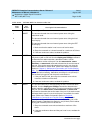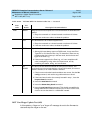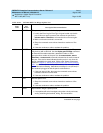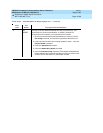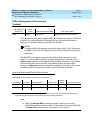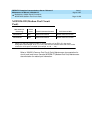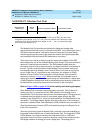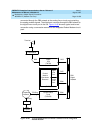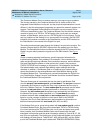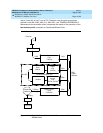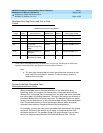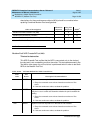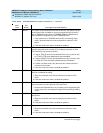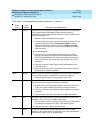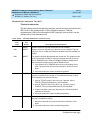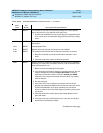
DEFINITY Enterprise Communications Server Release 6
Maintenance for R6vs/si
555-230-127
Issue 1
August 1997
Maintenance Object Repair Procedures
Page 10-831MODEM-PT (Modem Pool Port)
10
The Combined Modem Pool conversion resource is the second type available.
The function served by the Combined Modem Pool is similar to that of the
integrated Pooled Modem circuit pack, but the physical implementation is much
different. It has the advantage of supporting any speed the external modem can
support. The integrated Pooled Modem circuit pack can only support 300 or
1200 baud transmission rates. The Combined Modem Pool conversion resource
consists of a port on a TN742 or TN746 Analog Line circuit pack, an external
modem, a Data Module, and a port on a TN754 Digital Line circuit pack. The tip
and ring interface of the Analog Line is connected to the modem, the EIA 232C
interface of the modem connects to the Data Module, and the DCP interface on
the Data Module is connected to the Digital Line port.
The analog modem signals pass through the Analog Line port to the modem. The
modem converts these to EIA 232C signals which are passed on to the Data
Module. The Data Module further converts the signals to the DCP protocol for the
Digital Line port which passes the signals on to the PBX network. See Figure
10-67.
Certain customer-reported troubles may provide important information for
troubleshooting Modem Pool problems. For example, if the customer tries to
make a data call requiring a Modem Pool conversion resource, and the Modem
Pool and Data Module speeds or other options don’t match, they receive a
"CHECK OPTIONS" error message on the terminal. If this happens, the Modem
Pool administration and customer Data Module option settings should be
checked. In addition, if the Modem Pool is a Combined type, option settings
should be checked on the external Modem and Data Module making up the
Combined Modem Pool. The cabling and connections between the Digital Line
port, Data Module, Analog Line port, and Modem should be checked between
the Combined Modem Pool components.
There are three types of commands that can be used to test Modem Pool
circuits: test port, test modem-pool #, and test board. The test port command
is generally the first test to run after the Error Log is evaluated and an entry is
found for a Modem Pool port. The test modem-pool # command runs the same
tests as the test port short command performed on a Modem Pool port.
However, the test modem-pool # command can automatically test all ports in
the Modem Pool group number specified in #. The test board command
performs the same tests as test port and test modem-pool # plus additional
tests for circuits common to the entire circuit pack. Refer to the XXX-BD
(Common Port Circuit Pack) Maintenance documentation for information on
additional tests performed with test board (#50, #52, and #53).
If the Modem Pool port or group being tested with test modem-pool # contains
Combined Modem Pools, the ports on the associated TN742 or TN746 Analog
Line circuit pack and the TN754 Digital Line circuit pack are tested as a group.
Note, however, that Combined Modem Pools are not tested with the tests
described in this section and the repair information related to Tests # 96, 97, 98,
and 99 is not applicable. The Analog port of the Combined Modem port is tested
with Analog port tests (that is, Tests #6, #47, #35, #48 and #36), and the Digital
port of the Combined Modem port is tested with TDMODULE/PDMODULE tests



